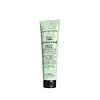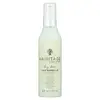What's inside
What's inside
 Key Ingredients
Key Ingredients

 Benefits
Benefits

 Concerns
Concerns

 Ingredients Side-by-side
Ingredients Side-by-side

Water
Skin ConditioningDicaprylyl Carbonate
EmollientCetearyl Alcohol
EmollientPolyquaternium-37
Myristyl Alcohol
EmollientC12-15 Alkyl Benzoate
AntimicrobialMacrocystis Pyrifera Extract
Skin ConditioningLaminaria Saccharina Extract
Skin ProtectingChlorella Vulgaris Extract
Skin ConditioningLactobacillus Ferment
Skin ConditioningArgania Spinosa Kernel Oil
EmollientPyridoxine Hcl
Skin ConditioningPhytic Acid
Glycerin
HumectantHydrogenated Polyisobutene
EmollientEthylhexylglycerin
Skin ConditioningButylene Glycol
HumectantCaprylyl Glycol
EmollientPPG-3 Benzyl Ether Myristate
EmollientLauryl Glucoside
CleansingTocopherol
AntioxidantZinc Sulfate
AntimicrobialGuar Hydroxypropyltrimonium Chloride
Skin ConditioningBehentrimonium Chloride
PreservativePentylene Glycol
Skin ConditioningPropanediol
SolventVinyl Caprolactam/Vp/Dimethylaminoethyl Methacrylate Copolymer
Skin ConditioningPolyquaternium-11
Stearyl Alcohol
EmollientParfum
MaskingLimonene
PerfumingEugenol
PerfumingPentaerythrityl Tetra-Di-T-Butyl Hydroxyhydrocinnamate
AntioxidantSodium Benzoate
MaskingPhenoxyethanol
PreservativePotassium Sorbate
PreservativeWater, Dicaprylyl Carbonate, Cetearyl Alcohol, Polyquaternium-37, Myristyl Alcohol, C12-15 Alkyl Benzoate, Macrocystis Pyrifera Extract, Laminaria Saccharina Extract, Chlorella Vulgaris Extract, Lactobacillus Ferment, Argania Spinosa Kernel Oil, Pyridoxine Hcl, Phytic Acid, Glycerin, Hydrogenated Polyisobutene, Ethylhexylglycerin, Butylene Glycol, Caprylyl Glycol, PPG-3 Benzyl Ether Myristate, Lauryl Glucoside, Tocopherol, Zinc Sulfate, Guar Hydroxypropyltrimonium Chloride, Behentrimonium Chloride, Pentylene Glycol, Propanediol, Vinyl Caprolactam/Vp/Dimethylaminoethyl Methacrylate Copolymer, Polyquaternium-11, Stearyl Alcohol, Parfum, Limonene, Eugenol, Pentaerythrityl Tetra-Di-T-Butyl Hydroxyhydrocinnamate, Sodium Benzoate, Phenoxyethanol, Potassium Sorbate
Water
Skin ConditioningParfum
MaskingBehentrimonium Chloride
PreservativePolyquaternium-37
Dicaprylyl Carbonate
EmollientGlycerin
HumectantCetrimonium Chloride
AntimicrobialSorbitan Oleate
EmulsifyingDiheptyl Succinate
EmollientPhenoxyethanol
PreservativeCaprylyl Glycol
EmollientIsopropyl Alcohol
SolventTocopheryl Acetate
AntioxidantLauryl Glucoside
CleansingSorbic Acid
PreservativeCapryloyl Glycerin/Sebacic Acid Copolymer
Skin ConditioningCocos Nucifera Oil
MaskingCamelina Sativa Seed Oil
Skin ConditioningHibiscus Rosa-Sinensis Flower Extract
HumectantWater, Parfum, Behentrimonium Chloride, Polyquaternium-37, Dicaprylyl Carbonate, Glycerin, Cetrimonium Chloride, Sorbitan Oleate, Diheptyl Succinate, Phenoxyethanol, Caprylyl Glycol, Isopropyl Alcohol, Tocopheryl Acetate, Lauryl Glucoside, Sorbic Acid, Capryloyl Glycerin/Sebacic Acid Copolymer, Cocos Nucifera Oil, Camelina Sativa Seed Oil, Hibiscus Rosa-Sinensis Flower Extract
 Reviews
Reviews

Ingredients Explained
These ingredients are found in both products.
Ingredients higher up in an ingredient list are typically present in a larger amount.
This ingredient is a preservative and often used for it's anti-static properties. You'll most likely see this ingredient in hair conditioners.
It does not cause irritation or sensitization in leave-on products at 1-5%.
Caprylyl Glycol is a humectant and emollient, meaning it attracts and preserves moisture.
It is a common ingredient in many products, especially those designed to hydrate skin. The primary benefits are retaining moisture, skin softening, and promoting a healthy skin barrier.
Though Caprylyl Glycol is an alcohol derived from fatty acids, it is not the kind that can dry out skin.
This ingredient is also used as a preservative to extend the life of products. It has slight antimicrobial properties.
Learn more about Caprylyl GlycolDicaprylyl Carbonate comes from carbonic acid and caprylyl alcohol, a fatty alcohol. It is an emollient and gives skin a velvet feel. The sources of Dicaprylyl Carbonate may be synthetic or from animals.
As an emollient, Dicaprylyl Carbonate creates a film on the skin. This film traps moisture in, keeping your skin soft and hydrated.
Glycerin is already naturally found in your skin. It helps moisturize and protect your skin.
A study from 2016 found glycerin to be more effective as a humectant than AHAs and hyaluronic acid.
As a humectant, it helps the skin stay hydrated by pulling moisture to your skin. The low molecular weight of glycerin allows it to pull moisture into the deeper layers of your skin.
Hydrated skin improves your skin barrier; Your skin barrier helps protect against irritants and bacteria.
Glycerin has also been found to have antimicrobial and antiviral properties. Due to these properties, glycerin is often used in wound and burn treatments.
In cosmetics, glycerin is usually derived from plants such as soybean or palm. However, it can also be sourced from animals, such as tallow or animal fat.
This ingredient is organic, colorless, odorless, and non-toxic.
Glycerin is the name for this ingredient in American English. British English uses Glycerol/Glycerine.
Learn more about GlycerinLauryl Glucoside sugar- and lipid-based cleansing agent. It is created from glucose and lauryl alcohol.
This ingredient is a surfactant, making it easier to rinse oil, dirt, and other pollutants away.
A British study found lauryl glucoside to cause skin sensitivity for some people. We recommend speaking with a professional if you have concerns.
Other names for this ingredient include "Lauryl Polyglucose", "Lauryl glycoside", and "D-Glucopyranoside".
Learn more about Lauryl GlucosideParfum is a catch-all term for an ingredient or more that is used to give a scent to products.
Also called "fragrance", this ingredient can be a blend of hundreds of chemicals or plant oils. This means every product with "fragrance" or "parfum" in the ingredients list is a different mixture.
For instance, Habanolide is a proprietary trade name for a specific aroma chemical. When used as a fragrance ingredient in cosmetics, most aroma chemicals fall under the broad labeling category of “FRAGRANCE” or “PARFUM” according to EU and US regulations.
The term 'parfum' or 'fragrance' is not regulated in many countries. In many cases, it is up to the brand to define this term.
For instance, many brands choose to label themselves as "fragrance-free" because they are not using synthetic fragrances. However, their products may still contain ingredients such as essential oils that are considered a fragrance by INCI standards.
One example is Calendula flower extract. Calendula is an essential oil that still imparts a scent or 'fragrance'.
Depending on the blend, the ingredients in the mixture can cause allergies and sensitivities on the skin. Some ingredients that are known EU allergens include linalool and citronellol.
Parfum can also be used to mask or cover an unpleasant scent.
The bottom line is: not all fragrances/parfum/ingredients are created equally. If you are worried about fragrances, we recommend taking a closer look at an ingredient. And of course, we always recommend speaking with a professional.
Learn more about ParfumPhenoxyethanol is a preservative that has germicide, antimicrobial, and aromatic properties. Studies show that phenoxyethanol can prevent microbial growth. By itself, it has a scent that is similar to that of a rose.
It's often used in formulations along with Caprylyl Glycol to preserve the shelf life of products.
We don't have a description for Polyquaternium-37 yet.
Water. It's the most common cosmetic ingredient of all. You'll usually see it at the top of ingredient lists, meaning that it makes up the largest part of the product.
So why is it so popular? Water most often acts as a solvent - this means that it helps dissolve other ingredients into the formulation.
You'll also recognize water as that liquid we all need to stay alive. If you see this, drink a glass of water. Stay hydrated!
Learn more about Water